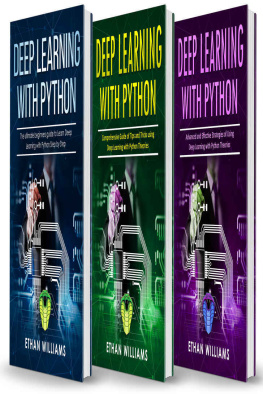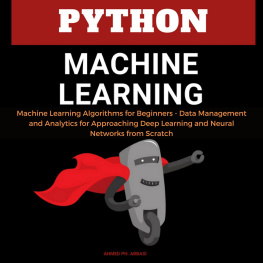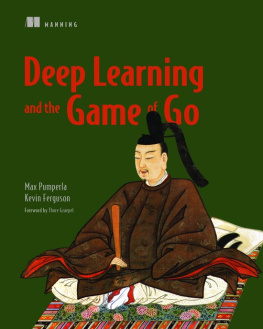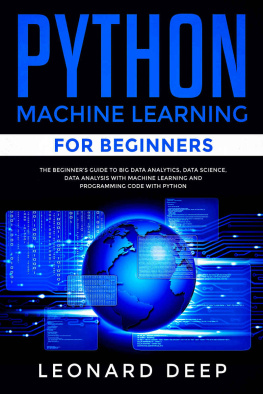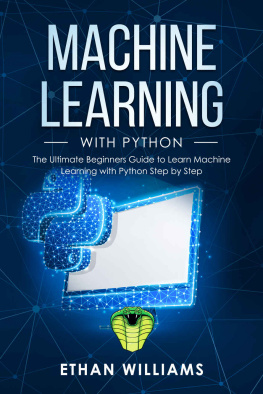Williams - Deep Learning with Python
Here you can read online Williams - Deep Learning with Python full text of the book (entire story) in english for free. Download pdf and epub, get meaning, cover and reviews about this ebook. year: 2020, genre: Home and family. Description of the work, (preface) as well as reviews are available. Best literature library LitArk.com created for fans of good reading and offers a wide selection of genres:
Romance novel
Science fiction
Adventure
Detective
Science
History
Home and family
Prose
Art
Politics
Computer
Non-fiction
Religion
Business
Children
Humor
Choose a favorite category and find really read worthwhile books. Enjoy immersion in the world of imagination, feel the emotions of the characters or learn something new for yourself, make an fascinating discovery.
- Book:Deep Learning with Python
- Author:
- Genre:
- Year:2020
- Rating:5 / 5
- Favourites:Add to favourites
- Your mark:
- 100
- 1
- 2
- 3
- 4
- 5
Deep Learning with Python: summary, description and annotation
We offer to read an annotation, description, summary or preface (depends on what the author of the book "Deep Learning with Python" wrote himself). If you haven't found the necessary information about the book — write in the comments, we will try to find it.
Deep Learning with Python — read online for free the complete book (whole text) full work
Below is the text of the book, divided by pages. System saving the place of the last page read, allows you to conveniently read the book "Deep Learning with Python" online for free, without having to search again every time where you left off. Put a bookmark, and you can go to the page where you finished reading at any time.
Font size:
Interval:
Bookmark:

Copyright 2020 - All rights reserved.
This document is geared towards providing exact and reliable information in regards to the topic and issue covered. The publication is sold with the idea that the publisher is not required to render accounting, officially permitted, or otherwise, qualified services. If advice is necessary, legal or professional, a practiced individual in the profession should be ordered.
- From a Declaration of Principles which was accepted and approved equally by a Committee of the American Bar Association and a Committee of Publishers and Associations.
In no way is it legal to reproduce, duplicate, or transmit any part of this document in either electronic means or in printed format. Recording of this publication is strictly prohibited and any storage of this document is not allowed unless with written permission from the publisher. All rights reserved.
The information provided herein is stated to be truthful and consistent, in that any liability, in terms of inattention or otherwise, by any usage or abuse of any policies, processes, or directions contained within is the solitary and utter responsibility of the recipient reader. Under no circumstances will any legal responsibility or blame be held against the publisher for any reparation, damages, or monetary loss due to the information herein, either directly or indirectly.
Respective authors own all copyrights not held by the publisher.
The information herein is offered for informational purposes solely, and is universal as so. The presentation of the information is without contract or any type of guarantee assurance.
The trademarks that are used are without any consent, and the publication of the trademark is without permission or backing by the trademark owner. All trademarks and brands within this book are for clarifying purposes only and are the owned by the owners themselves, not affiliated with this document.
TABLE OF CONTENTS
The Ultimate Beginners Guide to Learn Deep Learning
with Python Step by Step
Comprehensive Guide of Tips and Tricks
using Deep Learning with Python Theories
Advanced and Effective Strategies
of Using Deep Learning with Python Theories
with Python
ETHAN WILLIAMS
Introduction
Getting started in writing lines of codes can be a very tough experience. Once a beginner looks at the lines of codes consisting of a group of expressions and terms, he or she is likely to become scared. However, Python programming language will make your experience become sweeter in writing of codes and become a professional within a short period of time.
I believe that this is not your first interaction with the computer. If you are a daily user of a computer then you must have interacted with very many programs that assist you in performing various tasks on the computer. The programs can either be simulating an environment or even automation of tasks on the computer. For instance, if you want to perform tasks like counting the number of occurrence of words in a file or a word document you will require a small program to do so. You might also want to find a specific word in a document and either delete or replace it. All these operations require a suitable program in order to perform any specific action that you need.
In order to perform all these actions in a simple way, Python programming language is the best choice for you to learn and implement. This is a language that is very easy to use and easily available on the accessible operating systems like Mac OS, Windows and UNIX. It is an actual programming language that will help you to program with a lot of ease, develop support structures for larger programs and also eliminate the errors quickly as compared to other programming languages. It is important also to note that it is among the leading very high-level languages having several features like;
- High-level built-in data types
- Very flexible arrays
- Very flexible dictionaries
Before we go further into this programming language, many people get to ask why the program was named after reptile.
Why is it named after a Reptile?
It is important to note that it was never named after python, the reptile animal as many of us assume. It was named after the show Monty Pythons Flying Circus. The short history about this programming language is that it was implemented when the inventor Guido van Rossum was reading the published script from that comedy series. Guido was looking for a mysterious, short and a unique name and hence he decided to name the programming language as Python.
Short History of Python Programming Language
The program was developed in December 1989 by Guido van Rossum. Guidos passion and hobby was to write and learn new codes that were available during his time. It is documented that he developed the python programming language while interacting and learning the ABC programming language.
The program was developed during the era of the development of personal computers. The main objective of Guido was to make complex things to become simple to use. In addition, he focused on making many platforms supported as well as to communicate various libraries and multiple file formats. As a result of developing these features, the Python programming language became very popular in the market because people wanted to understand and use the computer in a simple manner.
Over the years, Guido decided to make the programming language open sourced. This became a greater opportunity for the public to assist in the development of the language. In the year 2000, Python 2.0 version was launched and released which became very community-based and transparent in terms of development. In the year 2008, Python 3.0 version was also released which portrayed a unique change to the programming language. These changes were accompanied with great features and compatibility to the new advanced operating systems. However, it limited the user to make choices between the 2.0 version and the 3.0 versions.
In summary, since the programming language was open-sourced, we expect a lot of advancements and developments on the language that will make it simpler and easier to use over the coming years.
Features of Python Programming Language
The Python programming language has endless advanced features that make your programming experience more splendid. For instance, it allows you to divide your larger problem into smaller tasks referred to as Modules in order to solve them quickly . In addition, the modules are universal in the language that they can also be used to solve other problems in the language. On the other end, the programming language also offers standard modules that you can use as basic skeletons of developing your own modules. Examples of such standard modules include; sockets, GUI interfaces, system calls and file Input/output.
This programming language was designed to be interpretative . This means that it does not require any compilation and linking of codes as compared to other programming languages. This feature helps the programmer to save a lot of time during the program development process. The design of the programming language also helps the programmer to interact freely with the programs in a way that he or she can get to write simple codes, test the functions of the codes and run the program efficiently. This feature makes this programming language to be compared to a handy desk calculator.
Next pageFont size:
Interval:
Bookmark:
Similar books «Deep Learning with Python»
Look at similar books to Deep Learning with Python. We have selected literature similar in name and meaning in the hope of providing readers with more options to find new, interesting, not yet read works.
Discussion, reviews of the book Deep Learning with Python and just readers' own opinions. Leave your comments, write what you think about the work, its meaning or the main characters. Specify what exactly you liked and what you didn't like, and why you think so.

